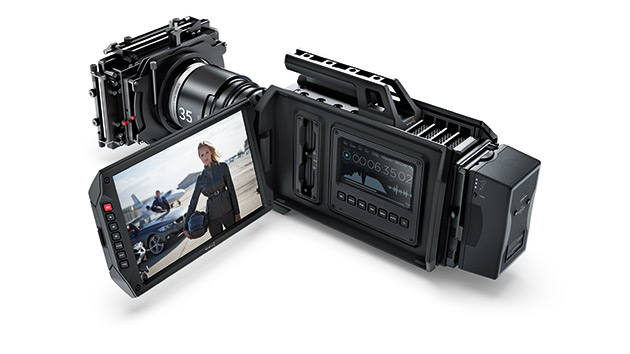Resolve 11 Gets Editing and Color-Grading Updates; Teranex Express Supports UHD at 60fps
Blackmagic Design launched two new camera lines at NAB this week—the Blackmagic Studio Camera with an MFT lens mount and a 10-inch viewfinder on the back, facing the operator, which is available in HD ($1,995) and 4K ($2,995) versions, and the 4K Blackmagic Ursa, which features a similarly distinctive 10-inch fold-out monitor as well as a second, five-inch screen for scopes, settings, and status views. The Ursa is slated to ship in EF- ($5,995) and PL-mount ($6,495) versions in June or July, and in a B4 (price TBD) lens-mount version later this year.
Blackmagic CEO Grant Petty said the design of the Ursa was inspired by seeing the way many owners tricked out their Blackmagic Cinema Cameras with rails and accesories that gave it a larger form factor that made more sense for production crews. "This camera is the center of a multi-person workflow," he said, with different "zones" for the DP, for the assistant, and for audio. The new design also allows efficient cooling to enable higher frame rates (up to 60p in HD and Ultra HD).
The Ursa records in 12-bit lossless compressed Cinema DNG raw and ProRes formats, and dual CFast 2.0 card recorders are built in. It also has a global shutter image sensor that can be upgraded by the user if a new and improved sensor design becomes available. We were told by Blackmagic's Bob Caniglia that all that is required is an Allen wrench.
Blackmagic is so confident this design is a winner that the Ursa will be available in a unique "HDMI" configuration ($4,495) with no sensor at all. The lens mount is replaced by a cheese plate and a HDMI input, allowing another camera (a DSLR, for example) to be wired into the URSA and take advantage of the body design.

The Studio Camera is built in a magnesium alloy body with a four-hour battery, mic connections with phantom power, and bidirectional optical fiber and SDI connections for connecting to a live production switcher. The HD version is shipping now and the 4K version is scheduled for June delivery.
What's the thinking behind the huge on-board monitors? "A great viewfinder is the most important thing when you're operating," Caniglia said by way of explanation.
Meanwhile, Blackmagic added more than 100 features to Da VInci Resolve 11, focusing on editing and color-grading. Key additions on this go-round include dual-monitor support, audio crossfades, dynamic JKL trimming, an improved title tool, the availability of plugins on the timeline, and collaborative timelines (rather than just projects) allowing one user, for example, to be cutting on the timeline while another user is grading it. A new auto-grade function sets a base look based on a color chart appearing in footage. You drag an on-screen grid to line up with the color chart, and the look gets tweaked automatically.
It's not that Blackmagic expects Da Vinci to become an NLE replacement, exactly, but that the new features make it more interoperable with other editing software. "The more editing features, the easier the interchange," Caniglia said. "It's like a Swiss army knife for every other NLE." Resolve 11 will be a free update, and is currently expected to arrive in June.
Blackmagic also announced two new Decklink PCIe capture cards with 6G-SDI and 4K HDMI, new 6G-SDI miniconverters at $295 each, and a $1,395 Teranex Express real-time SD/HD/UHD up- and down-converter with 12G SDI that's fast enough to support 60fps UHD. It also supports frame-accurate conversion of up to 16 audio channels. The Teranex Express ships in May.













Leave a Reply